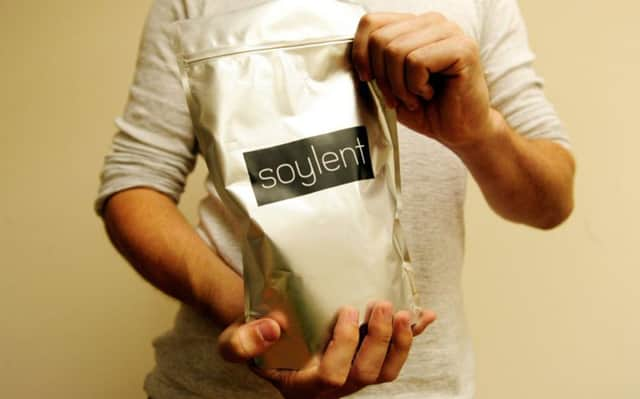Lori Anderson: Soylent leaves me hungry


It will all come flooding back: the carousel in Logan’s Run, Hal in 2001 – it is that benign soulless voice that robots use just before they destroy humanity.
Fans of dsytopian Seventies sci-fi will recognise the word Soylent as the “miracle” food stuff whose disturbing origin was uncovered by a khaki-clad, blood-soaked Charlton Heston who was stretchered off the screen while shouting: “Soylent Green is people!” Now that they’ve taken the people out, it’s not green anymore but is instead an inviting shade of cafe au lait.
Advertisement
Hide AdAdvertisement
Hide AdI do admire the cojones of a company who embrace irony and have the confidence to name their product after the least appetising food launch in cinema history. A new culinary trend is being poured. We’ve had “fast food” and “slow food” and now “no food”.
This month Rob Rhinehart, a 25-year-old graduate of electrical engineering from Georgia Tech, began shipping out a product that he believes will make food an antiquated idea. Soylent is a sealed bag of powder, which when mixed with water, tastes like unsweetened cake batter but contains all the nutrients, minerals and vitamins essential for human survival.
Rhinehart’s eureka moment came when he and two friends were struggling to develop an app in San Francisco and living on the bread line. Anxious to reduce his food bill to the bare minimum he realised he didn’t actually need bread, just carbohydrates; nor milk, just amino acids and lipids; and why spend money on steak or chicken when all you want is their protein?
Shopping for and cooking food consumed a large amount of people’s time, so in the spirit of “lifehacking” the new movement to streamline life, why not remove it entirely? After an intensive autodidactic course in food and nutrition he decided that 35 nutrients were required to comfortably sustain life, which he then ordered on the internet in powdered form. The recipe was a mix of trial and error with Rhinehart as the guinea pig. A batch that didn’t contain sulphur left him with joint pains.
The final recipe now contains all the major food groups, with lipids from canola oil, carbohydrates from maltodextrin and oat flour, protein from rice, omega 3 from fish oil (or flaxseed oil for vegans) as well as vitamins and minerals, magnesium, calcium and electrolytes. As he told the New Yorker magazine it is “everything your body needs”.
Soylent is selling like those hot baked goods it can now replace. The company reached its crowd-sourcing target of $100,000 (£6000) in two hours and quickly secured funding from Silicon Valley where rising to eat can be considered a rude interruption to a marathon coding session. Yet what makes Soylent different from other powdered foods – which have been around since the late 50s – is that it is viewed not as a supplement to a balanced diet but a replacement to one. Rhinehart now consumes the formula, which is sold in daily, 1500-calorie bags, for 90 per cent of all of his “meals”.
While I can understand the economics of feeding the poor for £40 a month, or adopting a “Soylent lifestyle” as a reaction to our current culinary obsessed world where food and its preparation dominates book-shelves and television channels, I do think there is something profoundly sad about choosing to consume “food” in the same manner as the seriously ill who can no longer eat.
We’ve been breaking bread and dining together for 10,000 years. The enjoyment of food is what makes us human and helps define our cultures and it’s hard to imagine sales of Soylent spiking in France, Italy or Greece. Recipes link one generation to the next through a crumb-strewn and sauce-stained piece of paper.
Advertisement
Hide AdAdvertisement
Hide AdDining together and the loving preparation of food is a sign of civilisation. Soylent is not a step forward as Rob Rhinehart believes but a step backwards if the goal is to persuade us that our lives will be richer and fuller if we dedicate the time previously spent in preparing home cooked meals to working longer at the office or hiking through the wilderness. What would Hestia, queen of hearth and home, say if the fridge, once filled with dark silken aubergines, plump roasted chicken, ruby red tomatoes and brown speckled eggs, was to be replaced by a cupboard of silver sealed bags of edible ash? She would point us to the words of Maurice Aubric quoted in Adam Gopnik’s book, The Table Comes First: “We eat to live? Yes, surely. But why then did the immortal gods, also come to the table, and twice a day?”